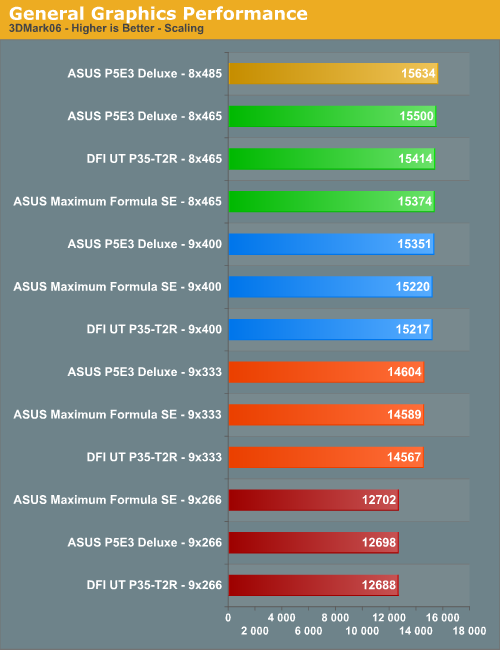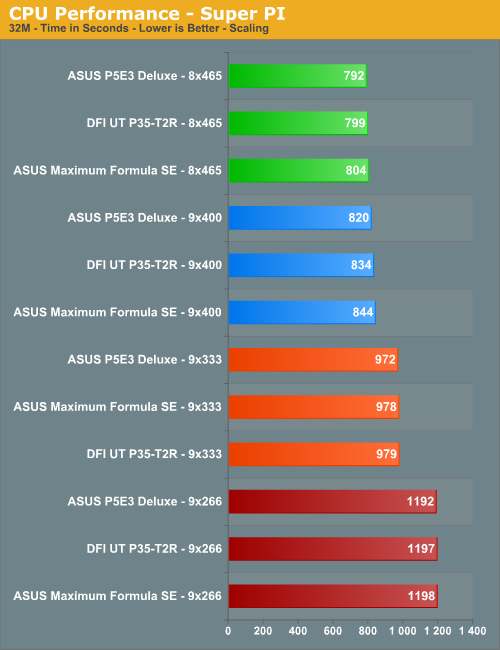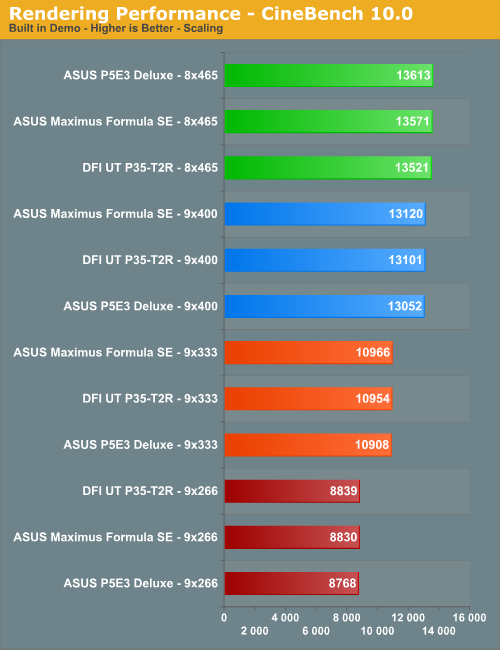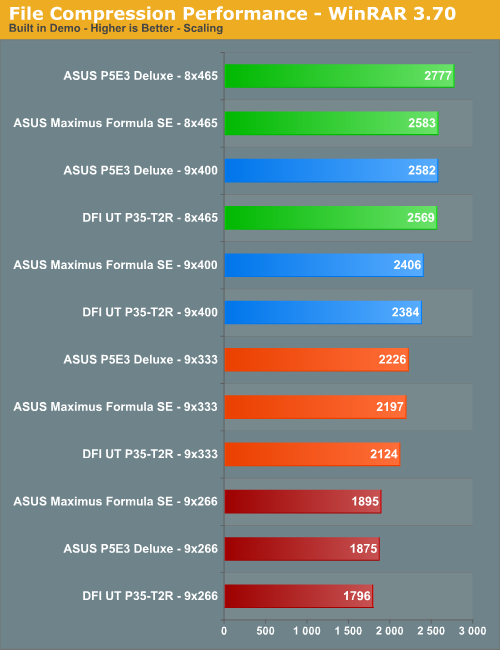ASUS P5E3 Deluxe Overclocking: DDR3 Takes Front Stage
by Kris Boughton on November 20, 2007 4:00 AM EST- Posted in
- CPUs
Overclocking Performance Comparison
All results were taken running memory ratios of 2:1 for final DRAM speeds of DDR-1066 @ 4-4-4-12, DDR-1333 @ 5-5-5-12, DDR-1600 @ 6-6-6-15, and DDR-1860 @ 8-8-8-15, respectively. This way we are able to capture any performance gain possible by taking advantage of the increased memory bandwidth provided by the DDR3 memory. Obviously, the DDR2 used in the testing of the ASUS Maximum Formula SE and the DFI UT P35-T2R needed to make use of lower dividers in order to maintain memory frequency within an achievable range.
Synthetic Graphics Performance

A close examination of the graphics results leads us to believe that, while nice to look at, DDR3 will do little to nothing in improving your overall gaming experience. This should come as no big surprise to anyone as we've known for a while that today's games are very much GPU dependent, especially at higher resolutions. The large performance gain in 3DMark06 seen when overclocking from 9x266 to 9x333 is a strong indication that the system was previously bottlenecked by the CPU when running at the stock 2.4GHz speed. Once we eclipse the 3GHz barrier though we start to see ever diminishing returns as we continue to push the processor higher and higher. This tells us that the system has now become GPU-bound and we can attribute any small gains in scores to the points we gain in the two CPU tests alone. Although the ASUS P5E3 Deluxe did manage to maintain a small lead across all phases of the graphics testing, the difference is hardly sizeable enough to justify the cost of DDR3, although this board will allow you to extract its full potential.
CPU Performance

We chose Super PI for testing the CPU/memory subsystem performance. Rather than run short sub-15 second tests that didn't do much to stress the memory we opted to run the longer 32M test. Small gains of approximately 1-3% are hardly groundbreaking. Nevertheless, the ASUS P5E3 Deluxe managed to maintain the performance lead in all test runs. The largest single score improvement was achieved during the 9x400 run with the MCH performance-optimized using a Static Read Control Delay of 6. In this case, tightening the sub-timings and setting Command Rate 1N may have been enough to bring the total time down to less than 800 seconds. We will continue testing this DDR3 and report additional results later.
Rendering Performance

CINEBENCH R10 is a great all-out CPU performance benchmark that scales wonderfully with the number of CPU cores in the system. As such, there is little to no gain seen by running the higher memory speeds provided by our DDR3. We will include Intel 45nm quad-core results in the next article.
File Compression Performance

Judging by the results of the built-in file compression benchmark provided in WinRAR 3.70 there is some additional performance available by providing the CPU with additional bandwidth - this makes sense, as file compression is quite data intensive, especially considering the amount of memory flip operations performed by this program. Here we see a solid 7% performance lead by the ASUS P5E3 Deluxe when running at 8x465.
All results were taken running memory ratios of 2:1 for final DRAM speeds of DDR-1066 @ 4-4-4-12, DDR-1333 @ 5-5-5-12, DDR-1600 @ 6-6-6-15, and DDR-1860 @ 8-8-8-15, respectively. This way we are able to capture any performance gain possible by taking advantage of the increased memory bandwidth provided by the DDR3 memory. Obviously, the DDR2 used in the testing of the ASUS Maximum Formula SE and the DFI UT P35-T2R needed to make use of lower dividers in order to maintain memory frequency within an achievable range.
Synthetic Graphics Performance

A close examination of the graphics results leads us to believe that, while nice to look at, DDR3 will do little to nothing in improving your overall gaming experience. This should come as no big surprise to anyone as we've known for a while that today's games are very much GPU dependent, especially at higher resolutions. The large performance gain in 3DMark06 seen when overclocking from 9x266 to 9x333 is a strong indication that the system was previously bottlenecked by the CPU when running at the stock 2.4GHz speed. Once we eclipse the 3GHz barrier though we start to see ever diminishing returns as we continue to push the processor higher and higher. This tells us that the system has now become GPU-bound and we can attribute any small gains in scores to the points we gain in the two CPU tests alone. Although the ASUS P5E3 Deluxe did manage to maintain a small lead across all phases of the graphics testing, the difference is hardly sizeable enough to justify the cost of DDR3, although this board will allow you to extract its full potential.
CPU Performance

We chose Super PI for testing the CPU/memory subsystem performance. Rather than run short sub-15 second tests that didn't do much to stress the memory we opted to run the longer 32M test. Small gains of approximately 1-3% are hardly groundbreaking. Nevertheless, the ASUS P5E3 Deluxe managed to maintain the performance lead in all test runs. The largest single score improvement was achieved during the 9x400 run with the MCH performance-optimized using a Static Read Control Delay of 6. In this case, tightening the sub-timings and setting Command Rate 1N may have been enough to bring the total time down to less than 800 seconds. We will continue testing this DDR3 and report additional results later.
Rendering Performance

CINEBENCH R10 is a great all-out CPU performance benchmark that scales wonderfully with the number of CPU cores in the system. As such, there is little to no gain seen by running the higher memory speeds provided by our DDR3. We will include Intel 45nm quad-core results in the next article.
File Compression Performance

Judging by the results of the built-in file compression benchmark provided in WinRAR 3.70 there is some additional performance available by providing the CPU with additional bandwidth - this makes sense, as file compression is quite data intensive, especially considering the amount of memory flip operations performed by this program. Here we see a solid 7% performance lead by the ASUS P5E3 Deluxe when running at 8x465.










25 Comments
View All Comments
retrospooty - Friday, November 23, 2007 - link
I should have added that beyond the current Intel roadmap, they are looking at Rambus XDR for future CPU's. DDR and its minor generational bumps arent going to cut it for long. DDR4 and DDR5 arent much better, higher speeds and higher latencies all the way = very minor performance increases.I really wouldnt advise anyone, even the enthusiests to get DDR3 now, in 1 more year Nehalem will be out with 3 channel DDR and it will likely be faster, or lower latency and cheaper than current DDR3 is, and anyone who fancies themselves and "enthusiest" will be upgrading again at that point, because 3 channel DDR3 on top of Nehalems internal memory controller WILL give a notable performance increase.
jkostans - Tuesday, November 20, 2007 - link
Spending an extra $50-100 on a GPU is still way more effective than spending the $200-300 more for DDR3. The only games that struggle with framerate on a modern mid-high end system are mostly GPU and somewhat CPU dependent. You get about the least bang for your buck with memory, but at the bleeding edge of performance I guess money is not a barrier.TA152H - Tuesday, November 20, 2007 - link
Another way to look at it is, would you rather have 1 GB of DDR3 or 2 GB of DDR2? They cost roughly the same.I'd rather have the 1 GB, since I can add more memory later. If you end up with DDR2, your system is forever degraded by inferior memory. You can't add it later unless you get a new motherboard. Besides, faster memory makes everything run faster, more memory only makes things run faster if you have to page (pretty much, I know Microsoft steals memory for caching, but that's a mixed bag anyway). Also, more memory wants more power.
I can already hear the argument from people saying that you can get 1 GB of DDR2 as well, and still realize a cost saving. It's a valid point, but at 1 GB the cost difference isn't that great, and I think the performance, and future upgradeability still make DDR3 attractive for some people.
LoneWolf15 - Tuesday, November 20, 2007 - link
Another way to look at it is, would you rather have 4GB of high-performance DDR2 for $150 (or cheaper, my 4GB of Crucial Ballistix cost me $140 this summer and is cheaper yet now), or 2GB of DDR3 for $200?
The industry must really love folks like you, who buy into the marketing hype. DDR2 is far from inferior, or Intel wouldn't have been using it all this time, and saying your system will be "forever degraded" is ridiculous tripe.
DDR3 has more bandwidth, but isn't necessarily "faster" as it is higher latency. That $150 DDR2 I mentioned has a CAS latency of 4; the $200 2GB DDR3 has a CAS latency of 7. DDR3 will only be attractive once it gains market share, lowering its price. What with enough P35 boards and some X38 boards still supporting DDR2, there is no reason to switch.
TA152H - Tuesday, November 20, 2007 - link
DDR3 is faster, if you can't accept that much, you aren't worth arguing with. DDR2 is inferior, but it's cheaper.DDR2 was not inferior until DDR3 came out. Inferior is a relative term, there has to be something better. Is English not your first language?
natebsi - Tuesday, November 20, 2007 - link
Sheesh. Personal attack much?TA152H - Tuesday, November 20, 2007 - link
Actually, you don't think his rant was a personal attack? If you don't agree with some people, you are just listening to marketing hype, or don't understand this or that. Instead of realizing there are reasons for both DDR2 (cost and compatibility) and DDR3 (everything else), you get people who accuse you of not understanding anything, and just being part of some company's marketing machine. It's so uneducated and insulting, it warrants something of the same kind back.Anyone that thinks DDR3 is completely useless, even now, is an idiot. This type of person is not worth arguing with. They are both useful, right now, and the arguments should really be about the gray areas where they begin to overlap. I might think DDR3's area is a little bigger than most, but at least I recognize that there are many people that are better off with DDR2. By the same token, I expect people to have at least basic intelligence and recognize there are areas where DDR3 makes more sense, even now. Pure performance always has a place, especially when it costs only $500, or less, more.
aeternitas - Sunday, December 9, 2007 - link
Grats on being the article clown.yyrkoon - Thursday, November 22, 2007 - link
I think the point if entirely lost on you.First, you can for instance get the same overclocks from DDR2 memory(at least from what I've seen here, because even my Promos 800 sticks can hit 1:1 475Mhz FSB which is 10Mhz faster than what I saw in the benches here).
Secondly, a system with 4GB of DDR2 vs 1-2GB of DDR3 *will* be more responsive. You can argue about it all you want, until you're blue in the face, and the only thing you will prove is that you have no actual hands on experience. Yes, this is even on a system with a 32BIT OS.
Thirdly, remember all the discussion a while back about AMD systems not performing any better than the Intel C2D systems despite having faster memory capabilities?
Lastly, even the writer of this article said the differences between the DDR2, and DDR3 system was barely a whisper . . .
But, you're right, anyone claiming that DDR3 RIGHT NOW is useless is an idiot, because they obviously can not see the eManhood effect capabilities here in saying that they paid X amount more for DDR3 vs DDR2. Anyone who has bragged about their $3000 usd set of car rims being much better than the stock rims that came with the car can surely see this point.
Griswold - Tuesday, November 20, 2007 - link
Oh yea I bet DDR3 makes perfect sense in your basement "lab" where you run your benchmarks all day long. Instead of yapping like a chihuaha with a superiority complex, you could instead just provide some realworld applications that make DDR3 not look like a waste of money right here, right now with todays hardware.Future proofing my ass, get a clue.